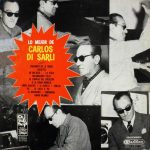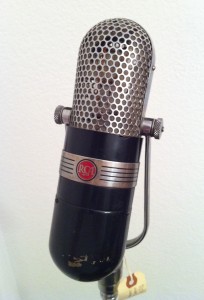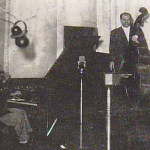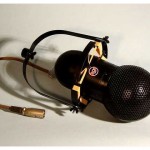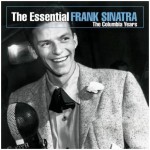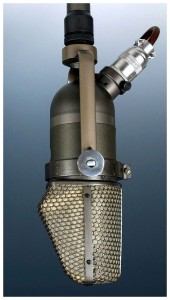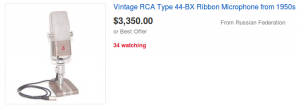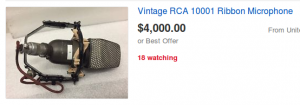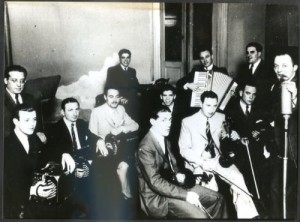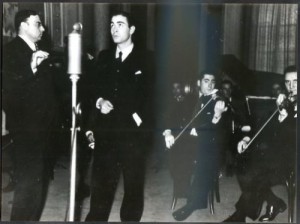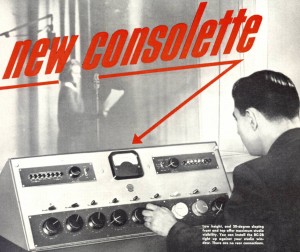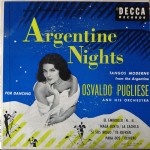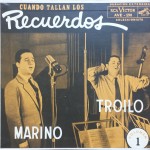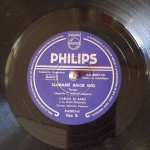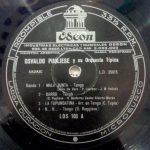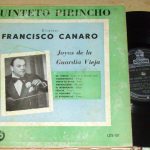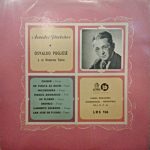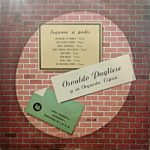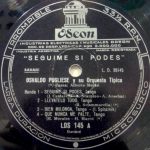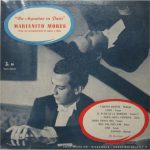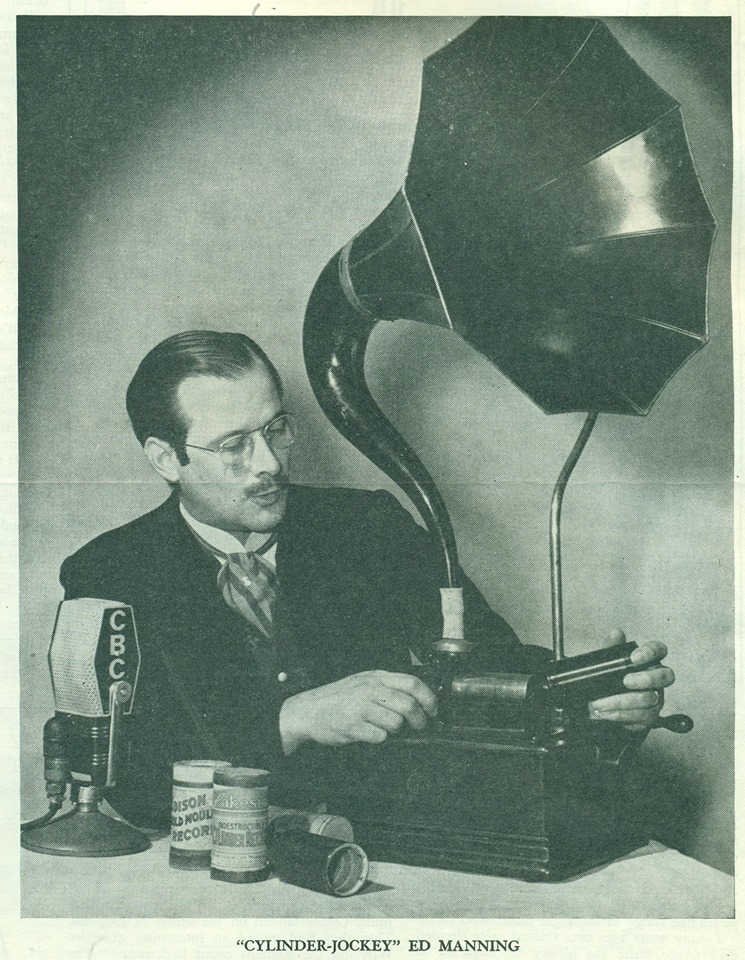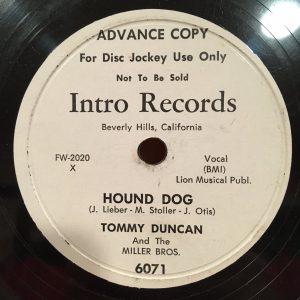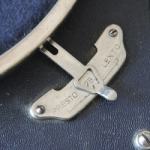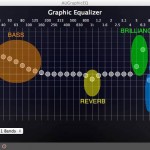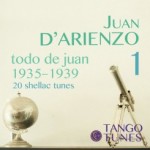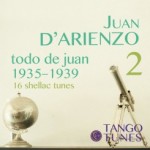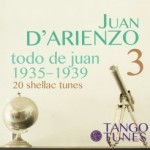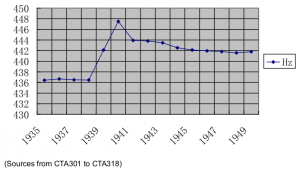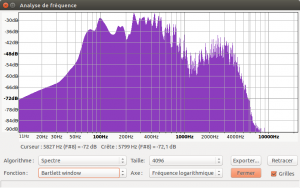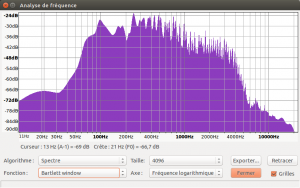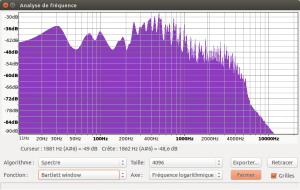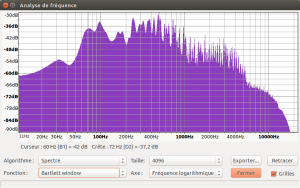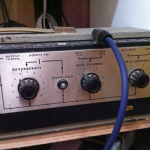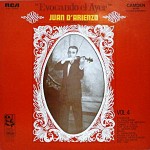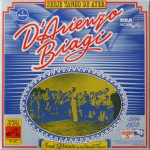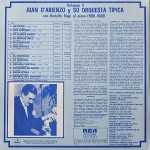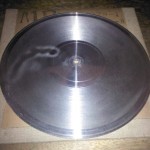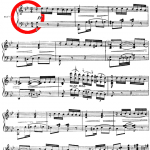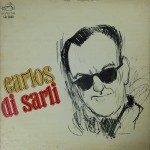
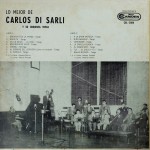 The other day I had this mysterious Carlos Di Sarli RCA vinyl LP in my hands. Mysterious because of a picture on the back cover which doesn’t seem to be contemporary to the recordings contained on the album. The record’s title is “Lo mejor de Carlos Di Sarli”. On the front cover there is a charcoal drawing of Carlos Di Sarli and to the left side his name: “Carlos Di Sarli” written in yellow and red on a big off-white background, a relatively minimalist graphic front cover. The hand-drawn aspect of the typography reminds a bit the fileteado art of Buenos Aires. Checking the tracklist on the back cover there are some instrumentals and the rest are recordings with Roberto Rufino and Alberto Podestá from the 1940s. The picture on the back cover seems at first glance out of context and completely unrelated to the record because it’s showing the later Di Sarli outfit from around the mid-1950s! That’s really strange and it took me some time to get all the puzzle pieces together but then this picture gives a lot of information about the Di Sarli orchestra, also some unexpected information. Let’s investigate this …
The other day I had this mysterious Carlos Di Sarli RCA vinyl LP in my hands. Mysterious because of a picture on the back cover which doesn’t seem to be contemporary to the recordings contained on the album. The record’s title is “Lo mejor de Carlos Di Sarli”. On the front cover there is a charcoal drawing of Carlos Di Sarli and to the left side his name: “Carlos Di Sarli” written in yellow and red on a big off-white background, a relatively minimalist graphic front cover. The hand-drawn aspect of the typography reminds a bit the fileteado art of Buenos Aires. Checking the tracklist on the back cover there are some instrumentals and the rest are recordings with Roberto Rufino and Alberto Podestá from the 1940s. The picture on the back cover seems at first glance out of context and completely unrelated to the record because it’s showing the later Di Sarli outfit from around the mid-1950s! That’s really strange and it took me some time to get all the puzzle pieces together but then this picture gives a lot of information about the Di Sarli orchestra, also some unexpected information. Let’s investigate this …
From CD collections we know that most of the time the editorial effort is quite low (unless there is an interesting extra booklet or some liner notes), essentially we will find on the typical tango CD a list of around 20 tracks which follow a chronological order from the earliest recording to the latest. On the present LP album, it’s a little bit different. The record is called “The Best of Carlos Di Sarli” and indeed there has been a particular selection on the 2 times 7 tracks: There are exclusively recordings with the singers Roberto Rufino and Alberto Podestá, each represented with 5 recordings and there are 3 instrumentals on each side, 6 instrumentals altogether. I expect a lot of people would refute that selection and consider it a non-representative sample of what should be considered “The Best of Carlos Di Sarli”. A choice somehow exclusively limited to these two, indeed important singers, but not the only ones … Nevertheless, this is a strong statement, the editor who prepared the LP tells us: “The best of Di Sarli is Rufino, Podestá and some instrumentals and nothing else. Basta!”
The record is a re-edition of inital shellac releases, it was issued in the series RCA Camden Coleccionista (CAL-3080) somewhere in 1967. It is therefore a posthumous edition as Di Sarli died on 12.1.1960. Tango vinyls are difficult to date because dates were rarely indicated on the records mostly to keep them as evergreens and especially this LP series was on for a long time. In this series the record numbers with the prefix CAL were for records in mono and the prefix CAS was used for stereophonic transfers (on the stereo CAS-3080, there is an alternative front cover, a collage of several portrait photographs of Carlos Di Sarli). “The label was named after Camden, New Jersey, original home to the Victor Talking Machine Company, later RCA Victor. It specialized in reissuing historic classical and popular recordings from the extensive RCA Victor catalog. The long play albums originally sold for $1.98 retail and consisted of [main]ly monoaural recordings, often drawn from 78-rpm masters.” [Wikipedia]
Looking closer at the back cover picture there is neither Rufino nor Podestá on it. They were long gone when that picture was taken. Curiously you will see two other singers: Rodolfo Galé and Argentino Ledesma who are not on any recording of the present record! Iconographically spoken, there is a contrariety: On the front cover you have Carlos Di Sarli in portrait and in a typogram, solo, and on the back cover Carlos Di Sarli in action together with his big mid-1950s orchestra. The album contains vocal recordings with Rufino and Podestá but there is no picture of them on the covers …
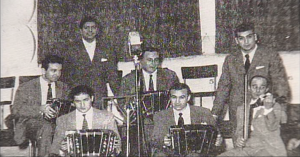
Blow-up of the back cover picture, showing Argentino Ledesma and Rodolfo Galé standing behind the orchestra. What are they doing on a record with Rufino and Podestá?
In contrast to the rather difficult dating of the record itself, the picture on its back cover can be precisely dated because of the random presence of the two other singers. Like bystanders, they just happen to feature on the picture: Argentino Ledesma (background left) and Rodolfo Galé (background right) standing in the last row behind the orchestra. These two singers were shortly recording with the Di Sarli orchestra in the year 1956 between 3.2.1956 and 7.3.1956, around one month only! With Argentino Ledesma, Di Sarli recorded three tangos and with Roberto Galé one tango and one vals. Both were a little later replaced by Roberto Florio and Jorgé Durán. Together with the single tango recording Carlos Di Sarli made with the singer Carlos Acuña on 2.8.1941 “Cuando el amor muere” and his last singer in 1958, Horacio Casares, they are among his shortest casts, both in time and number of recordings. So we now know that the picture has been taken in between February 1956 and beginning of March 1956. We can even further track down the precise day when this photograph has been taken because there is only one day when both, Galé and Ledesma were together in the studio! On the 3.2.1956 Carlos Di Sarli recorded a single 78-rpm record, RCA-Victor 1A-0752, with the tango “Fumando espero” sung by Ledesma on the A side and “Noche de locura” sung by Galé on the B side. Therefore, most likely, the picture was taken on the 3.2.1956.
But why using a picture from the 1950s to illustrate a record with singers from the 1940s? Listening to the record I found out that most of the instrumental tracks don’t sound like being from Rufino’s and Podestá’s time. And as the record doesn’t indicate any recording dates next to the titles I started my own analysis. The outcome is the following extended tracklist:
A1 Organito de la tarde – Carlos Di Sarli : Instrumental – Tango – 31.8.1954
A2 Griseta – Carlos Di Sarli : Roberto Rufino – Tango – 21.6.1941
A3 En un beso la vida – Carlos Di Sarli : Roberto Rufino – Tango – 23.9.1940 (C: Di Sarli)
A4 Milonguero viejo – Carlos Di Sarli : Instrumental – Tango – 4.7.1940 (C: Di Sarli)
A5 Zorzal – Carlos Di Sarli : Roberto Rufino – Milonga – 3.12.1941
A6 Al compás del corazón | Late un corazón – Carlos Di Sarli : Alberto Podestá – Tango – 9.4.1942
A7 El choclo – Carlos Di Sarli : Instrumental – Tango – 30.6.1954
B1 A la Gran Muñeca – Carlos Di Sarli : Instrumental – Tango – 30.6.1954
B2 Nido gaucho – Carlos Di Sarli : Alberto Podestá – Tango – 30.11.1942 (C: Di Sarli)
B3 Verdemar – Carlos Di Sarli : Roberto Rufino – Tango – 7.10.1943 (C: Di Sarli)
B4 La capilla blanca – Carlos Di Sarli : Alberto Podestá – Tango – 11.7.1944 (C: Di Sarli)
B5 El ingeniero – Carlos Di Sarli : Instrumental – Tango – 31.1.1955
B6 Tú, el cielo y tú – Carlos Di Sarli : Alberto Podestá – Tango – 8.11.1944
B7 Bahia Blanca – Carlos Di Sarli : Instrumental – Tango – 21.11.1957 (C: Di Sarli)
Surprisingly I found out that the instrumental titles on the record are mostly from his return to the RCA Victor label since the year 1954, like the first track A1 “Organito de la tarde”. Adding to the confusion, Tangotunes states that the track is the version from 1942 but according to me it doesn’t fit several markers and it has the clear 50’s sound. It cannot be the 1951 Music-Hall version as this is a RCA record. Track A4, “Milonguero viejo” is from the 1940s, like all vocal tracks A2, A3 and A5 with the voice of Rufino and A6 with Podestá. The last instrumental track on the A side is “El choclo”. It is most probably from 30.6.1954, as the 1951 version was recorded under Music-Hall a repertoire to which RCA had no access.
But check for yourself, I have provided here two of my own digital transfers from the A side of this LP, first “Organito de la tarde”, then “Milonguero viejo”:
Organito de la tarde (31.8.1954):
Milonguero viejo (4.7.1940):
On B1 “A la Gran Muñeca” is dated by Tangotunes to 29.8.1945. I would rather date it to 1954. The vocal tracks B2, B3, B4 and B6 are all from the 1940s. B5 “El Ingeniero”, triggers again a doubt because there are 3 recorded versions: 20.2.1945, the MH version from the beginning of the 1950s and the version from 31.1.1955. For me it’s missing the sweetness and tempo of the 1940s version therefore I think it’s the 1955 version. B7 “Bahia Blanca”, maybe the most difficult to distinguish as he recorded it twice in a very short period of time: 27.11.1957 and in 1958, on his last recordings with the label Philips, but as we deal here with a RCA record we can be confident that it’s most certainly the 27.11.1957 version. This is important to underline, the record companies never published the recordings of other record companies because they didn’t own the rights and also they didn’t have a master to make the copies.
I tested the recordings on several markers in comparison to other sources but there is something else which is quite evident when watching the VU meter: The line level of the 1950s tracks is stronger than that of the 1940s tracks! They are louder with a wider dynamic range and are therefore standing out, easy to identify. As a conclusion we can say that apart from “Milonguero viejo” all of the instrumental tracks on the present record are from the 1950s!

Spectrogram of “Milonguero viejo”: the 1940s tracks have thinner regions above 10kHz and less detail in the bass

Spectrogram of “El choclo”: the 1950s tracks have full frequency range from deep bass up to 20Khz. Between the recording “Milonguero viejo” and “El choclo” there are 14 years in which the microphones have been immensely improved!
That extends the editorial statement and makes the relation to the back cover picture more meaningful: The editor now tells us the best of Carlos Di Sarli are also his 1950s instrumentals. And indeed, it’s the time when he found to his most typical sound: Marking the rhythm with the strings, banishing the bandoneóns into the background and developing a lot of energy with a relatively slow tempo! Whereas the 1940s were characterised by his most emblematic singers: Roberto Rufino with whom he started into the golden age at the beginning of the 1940s and the little later arriving Alberto Podestá. Even nowadays no milonga without at least one tanda Di Sarli/Rufino or Di Sarli/Podestá! And also, did you recognise? Around half of the recordings on the record are Carlos Di Sarli’s own compositions! Like Milonguero viejo which he composed in the late 1920s shortly after his participation in Osvaldo Fresedo’s orchestra.
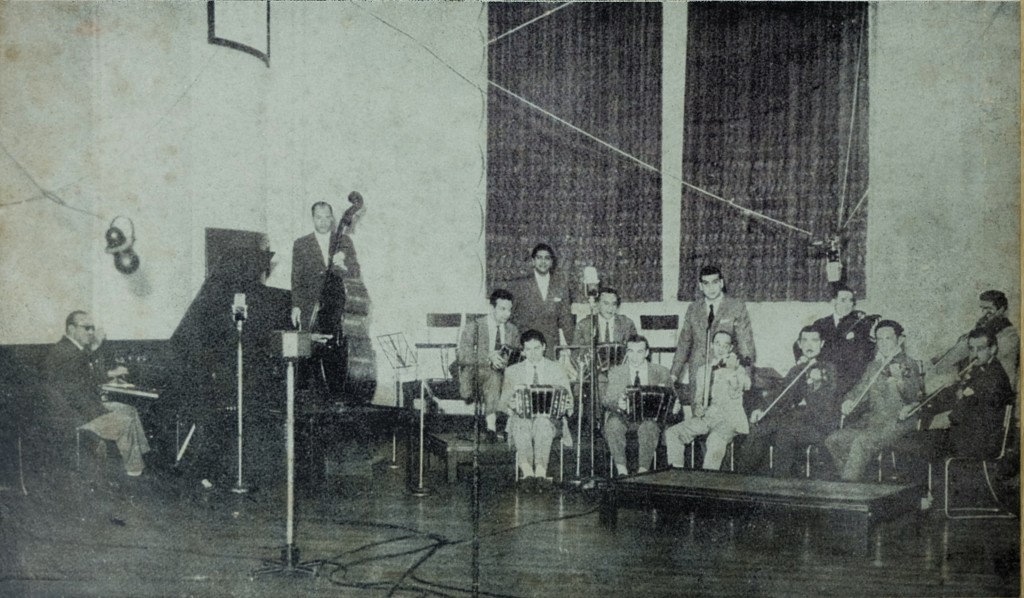
The full back cover picture of Carlos Di Sarli and his gran orquesta in the recording studio of RCA Victor probably taken on 3 February 1956
So let’s dive a little deeper into this picture of the Carlos Di Sarli orchestra. The picture is taken in a big RCA recording studio in Buenos Aires, maybe during a sound check or a pause and we can see all the microphones placed at their final recording position. There are also some podiums to higher the second row of instruments. That’s a trick which dates back to the time when recordings had been made acoustically during the Guardia vieja. And that was still an advantage in the current situation because the studio technique of RCA Victor in the mid-1950s consisted of organising the instruments into recording groups and not to pick them up individually like we would expect nowadays. To the right there is the string section and their group microphone is flying overhead. Next, in the middle, the bandoneón section has its dedicated microphone placed in front. Then to the left side, the grand piano and the double bass are sharing a microphone on a stand in a perfect triangulated position. There is another flying microphone, probably for the vocalist who had to stand just next to Carlos Di Sarli. This changes to the former 1-2 microphones technique which we know from the late 1920s until the 1940s. Like in the following picture of the Ricardo Tanturi Típica which might have been taken in the same location some 10-12 years earlier:
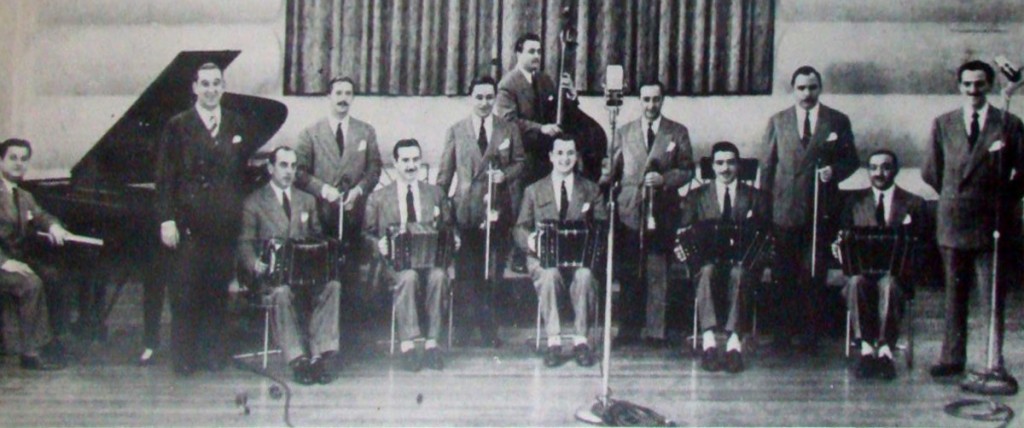 By the way, notice that Ricardo Tanturi has the role of a conductor, there is someone else behind the piano. According to Gabriel Valiente’s Encyclopedia of Tango (Reprinted with corrections version of 2014), Ricardo Tanturi is reputed to have played the piano during his recording sessions with Alberto Castillo between 23.06.1937 and 07.05.1943. At least since the sessions with Enrique Campos he left that position, maybe to conduct the orchestra as we can see on the present picture. Some sources say that Ricardo Tanturi never was on the piano during any recording session because the playing style is too much tainted by that of Armando Posada, pianist of the orchestra on the left side of the photograph. The photograph must have been taken the earliest around August 1943, or later, as it is in August 1943 that Tanturi went first into the studio with Enrique Campos.
By the way, notice that Ricardo Tanturi has the role of a conductor, there is someone else behind the piano. According to Gabriel Valiente’s Encyclopedia of Tango (Reprinted with corrections version of 2014), Ricardo Tanturi is reputed to have played the piano during his recording sessions with Alberto Castillo between 23.06.1937 and 07.05.1943. At least since the sessions with Enrique Campos he left that position, maybe to conduct the orchestra as we can see on the present picture. Some sources say that Ricardo Tanturi never was on the piano during any recording session because the playing style is too much tainted by that of Armando Posada, pianist of the orchestra on the left side of the photograph. The photograph must have been taken the earliest around August 1943, or later, as it is in August 1943 that Tanturi went first into the studio with Enrique Campos.
The microphone on the right side next to the singer Enrique Campos, is a RCA Type 77. Which was a very versatile microphone. It could be modified through a simple switch and therefore be used for different applications. For vocals it had a selectable cardioid pattern. Up to now, I was thinking the microphones used in that time would be completely obsolete nowadays. But apparently they are still in use and occasionally sold via eBay for very high prices. And I also learnt during my research, they still find their application in some modern recording studios! It is also important to note that these microphones were under constant development and for instance the RCA Type 77 went through several sub types, with the A model initially developed in the 1930s. Until the year 1945, there have been a B, C and then a D model. The D model reached in 1945 a frequency range from 50Hz-15kHz. It was definitely replaced in 1955 by the RCA Type 77-DX. These microphone improvements are something you can really hear when you compare recordings from the 1920s, 1930s, 1940s and 1950s (see also the spectrograms above for a 1940s to 1950s comparison).
The orchestra microphone in the middle of the Tanturi picture is most likely a RCA-44A or one of its successors. It’s the orchestra microphone par excellence and was manufactured since 1932. It later evolved to an incredible frequency response of 30 to 16kHz which is pretty much the full audible spectrum! It’s the central orchestra microphone in the Tanturi picture and might be the same type on the Di Sarli picture. Most of the ribbon microphones were construction-related omni-directional and some were modified through obturation and electrical modifications to become directional or to have other pickup patterns. RCA Victor’s instructions manual shows how to use a 44A microphone in a single microphone setup and how to take advantage of its omni-directional sensitivity in the form of an 8:
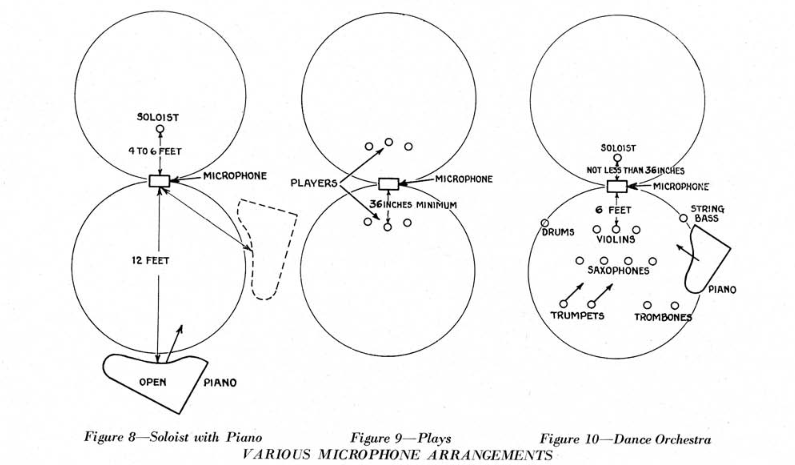
RCA’s suggestion for setting up the RCA-44 microphone and taking advantage of the omni-directional 8 pattern to record a dance orchestra or use it as a movie microphone with some actors
Nowadays a 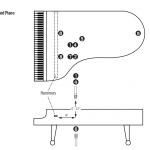 grand piano would be picked up with a complex microphone setup inside the body of the piano, maybe using Blümein arrays to get a perfect stereo image as shown in the diagram to the left. The disadvantage of a setup like this is that one needs to EQ and compress quite a lot the obtained signal to get it right. It needs a lot of post-processing which was largely unavailable in 1950s and earlier. Also, these complex setups are more suited for recording solo pianos and not so much orchestras where there is a piano in the context of other instruments.
grand piano would be picked up with a complex microphone setup inside the body of the piano, maybe using Blümein arrays to get a perfect stereo image as shown in the diagram to the left. The disadvantage of a setup like this is that one needs to EQ and compress quite a lot the obtained signal to get it right. It needs a lot of post-processing which was largely unavailable in 1950s and earlier. Also, these complex setups are more suited for recording solo pianos and not so much orchestras where there is a piano in the context of other instruments.
There is a simpler technique with one microphone from the side which is more fitted for a piano in an orchestra context. It’s the same technique RCA Victor used in the 1950s with Carlos Di Sarli:
Putting the string bass next to the piano is a suggestion which can also be found in the above mentioned RCA microphone manual. The setup in the Di Sarli situation is very much identical.
As Di Sarli was conducting his orchestra from behind the piano, I can image that he would have liked to have the singer very close to be able to communicate and that’s what the second flying microphone on the left side was meant for. There are some other documents which show that it was used for vocalists, like on that Frank Sinatra photograph. It’s a RCA KU-2A, with an unusual uni-directional cardioid pickup pattern and a uniform response in its operating range making it ideal for voice recording (the majority of ribbon microphones are omni-directional “8” pattern microphones). Most studio vocal recordings are made using a cardioid or uni-directional microphone, as these pick up less sound from the sides and rear.
If we move to the right side of the picture, we see the other flying microphone above the violin section. A violin has a frequency range between approximately 196 hz to 10 khz which is the exact frequency range of the RCA KU-3A uni-directional cardioid pattern microphone (very simular to the KU-2A). To my surprise it’s again manufactured by the company AEA as the AEA KU4 Supercardioid Ribbon Microphone at a price of around 6000€!
If the bandoneón section is recorded with a RCA-44A which can be seen on the stand in front of this instrument group (maybe a RCA-44BX if they updated in 1955 when the improved model came out), then there is a slight difference of how the sound of the bandoneóns is recorded compared to the violins (the bandoneóns from the front and the violins from above). Remember that since at least the beginning of the 1950s the violins are centerstage and marking the rhythm in Di Sarli’s orchestra. This central role could have been further emphasized by the use of two different kind of microphones for these two instrument groups so that the treatment of the sound places them on different layers in the musical image.
Quickly checking the cast of Carlos Di Sarli’s orchestra on the picture, we can see that there are six violins, four bandoneóns, one double bass and a piano. In the historical accounts, like Gabriel Valiente’s Encyclopedia of Tango, Carlos Di Sarli is supposed to have only five violins in 1956: Szymsia Bajour, Elvino Vardaro, Elías Slón, Alfredo Rouco and Antonio Rossi. There is one more in the picture. Who is the sixth? The bandoneón section is pretty much the official cast: Upper right side José Libertella, upper left side Alfredo Marcucci; Julián Plaza and Domingo Sánchez in the front row; Carlos Di Sarli on the piano and Alfredo Sciarreta on the double bass. And last but not least the two singers on the substitutes’ bench 🙂
As we have recognised RCA Victor was using its own recording technology and gear. No other foreign brand or equipment to see here. There is still an unidentifiable object in the forefront of the picture with a maybe hexagonal shape. It looks like a talkback or intercom system, for the control room to communicate with the musicians, or maybe some sort of timer. A lot of the electronic equipment, like limiters and later even compressors, were self-made by the sound engineers, maybe it’s such a customised device. I couldn’t find anything about it, so it’s pure speculation. But my best guess is that it’s just an ashtray on a stand 🙂
Odeón, the other big record company in Buenos Aires was working mainly with German equipment as one can see on numerous photographs of artists and bands who were under contract with that label.
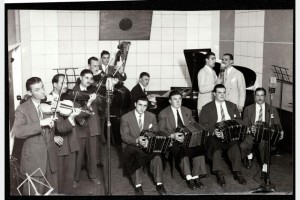
“Osmar Maderna (piano) y su orquesta. De derecha a izquierda, adelante, el segundo es Leopoldo Federico. Estudio del sello SONDOR. Año 1946.”
Generally, one should pay attention as on some photographs you might see RCA Victor equipment with these artists too. Mainly, these were taken in radio studios most of which were equipped with RCA Victor gear. RCA did not only produce records but also sound equipment for the cinema, radio and later for television studios. Therefore you might find their microphones on pictures with Odeón artists performing at Radio Splendid or Radio LR1 El Mundo. Odeón’s German equipment seems to be coming from Telefunken (probably produced at the Neumann factory in Berlin) like the Ela M-14 bottle style microphone and alike, which were, compared to the RCA Victor microphones, condenser microphones. Pretty much as the ones we commonly use today. That could explain why RCA Victor and Odeón recordings do have another sound. Do you remember that Aníbal Troilo recorded his first record with Odeón in 1938? It sounds very different to the records he did when he signed with RCA Victor in 1941. His Odeón titles “Tinta verde” and “Comme il faut” are therefore difficult to put into a tanda with later instrumentals and one is tented to apply some equalization to pretend they would have the same sound. They actually don’t! Odéon was using condensor microphones whereas RCA Victor used ribbon microphones!
In 1944, on the other side of the Rio de la Plata, in Montevideo, the newly established Uruguayan record label Sondor seemed to be equipped as well with RCA Victor recording material. As you can see on the photograph to the left showing Osmar Maderna’s orchestra in the new Sondor studios. They were very much grouping by instrument groups and using several microphones already in the late 1940s! Maybe they had a very modern mixer because they used three microphones. There is only a maximum of three years difference to the Ricardo Tanturi photo above.
The technology used in the control rooms is of pure speculation, we know for certain that since the first multi microphone recordings there needed to be some sort of mixer in front of the sound engineer. In the beginning when there was a single microphone in the studio a single channel and a rotary knob to determine the gain would have been sufficient, later one needed a channel per microphone. That wouldn’t mean necessarily multi-track as these channels were always down-mixed into a single mono channel. Multi-track recording started to develop since the end of the 1950s with the first stereo equipment (2 channels) and multi-track reel-to-reel tape machines with several channels. That opened the field to post production steps and slowly ended the pure direct-to-disc recording technique. At least in theory.
To make a direct-to-disc recording, musicians would typically play one 3-minute “live” set in a recording studio. The recording was made without multi-track recording and without overdubs. The performance was carefully engineered and mixed live in monophonic sound. During the performance, the analog disc cutting head engaged the master lacquer used for pressing records and is not stopped until the entire side is complete.
I can image that during the 1950s RCA sessions, they still produced under direct-to-disc conditions, having one output master channel going directly to a lathe cutting a 78-rpm wax and maybe optionally a second output master to tape. Direct metal masters were ideal and fast for the production of shellacs records whereas for vinyl a tape master was more suited and direct to the goal. Therefore for an intermediate period, in between the end of the shellac era and the not yet fully started vinyl times, this would have made sense and the mixers had this capacity of double output. In the radio studios, it was used to direct one audio feed to the broadcast antenna and the other to a transcript acetate disc cutter to record the radio feature for later broadcast or archival. Even later, during the vinyl age, there still have been experiences with direct-to-disc recordings because this process has a very authentic aspect.
“Direct-to-disc recording meant that there was no way to cheat or to alter the result and there had been very few takes because of the high price and intensive preparation work of the recording support. Most of the time these sessions were done in one flush at first take. Unimaginable today. Though, this direct-to-disc process had been around until the end of the LP era as you can read in the aforementioned Wikipedia article! And it’s coming back, look for instance at the new label Berliner Meister Schallplatten, they are reintroducing the direct-to-disk process with vinyls and taking it to a new climax, they even invite the public into the studio during a recording session. The direct-to-disk process makes me think about Roland Barthes who wrote about silver photography in his essay ‘La Chambre claire’, long before the advent of Photoshop, that the noema of photography is the shocklike ça a été (that has been), as with these direct-to-disk recordings which are an immediate conserved state of sound without any cosmetics! A shocking document of what has been … A great deal of the emotions we live while listening or dancing to these recordings certainly result from this circumstance!” [Quoting myself: http://jens-ingo.all2all.org/archives/1794]
- 7″ vinyl Osvaldo Pugliese 1953 North American vinyl repressing of initially on shellac published titles. It was aimed for the North American market
- 7″ vinyl Aníbal Troilo RCA Victor AVE-190, one of RCA’s early vinyls, extended-play, is a reissue of Troilo Marino, initially published as shellac
- Last recordings of Carlos Di Sarli, 1958, still on shellac! There were 7 shellacs recorded with Philips = 14 titles
- Grouping LP with Carlos Di Sarli’s last 12 titles, compared to the initial shellac issues, 2 titles are missing (one shellac) (LP issued around 1960)
The first microsurgo (microgroove) records, in short LP (33 1⁄3 rpm), were issued in the first half of the 1950s and were mostly reissues or grouping albums of preceding shellac pressings, either in extended-play format on 7″ records (EP) or as long-play records (LP) (first as 10″ with 2×4 tracks, then towards the end of the 1950s as the full size 12″ LPs like we know them today with 2×6 or 2×7 tracks). Starting at around 1953, Odeón is among the earliest labels to issue vinyls as 10″ records in their LDS series and as 7″ in their DSOA series with artists like Osvaldo Pugliese, Mariano Mores, Carlos Gardel, Francisco Canaro, Oscar Alemán, Roberto Firpo and others.
- Osvaldo Pugliese LDS-103, circa 1953
- LDS-103 (detail of the record label)
- Francisco Canaro LDS-121, circa 1953
- Osvaldo Pugliese, LDS-136
- LDS-136 (detail of the record label)
- Osvaldo Pugliese LDS-145, circa 1953
- LDS-145 (detail of the record label)
- Mariano Mores “Un Argentino en París” LDS-182 ~1954 (recorded in France)
In general no genuine new stuff. Some exceptions confirm the rule: Mariano Mores’ first LP “Un argentino in París” from 1954 is maybe one of the first genuine vinyl productions in Argentina. The recordings of the day were still first issued on the older shellac 78-rpm support. For the record companies the conversion to the new technology represented certainly a big investment but also the households had to buy new record players to be able to playback the newer vinyls. Bringing the older music as vinyl samplers on the market enabled the record labels to test vinyls sales without taking too much risk. It also transferred the older music to the new format and made it available. Even the last Carlos Di Sarli recordings were issued first on shellac and later on a grouping LP and, to be precise, it was in the beginning of 1952 that Carlos Di Sarli became the first tango artist to be published directly on vinyl at Music-Hall on 7″ records starting with the record number LP-1001 in February 1952. Music-Hall later reduced the number of issued vinyl copies and then completely moved the series back onto shallac 78-rpm as the consumers weren’t ready for the new medium. This slow shellac-vinyl conversion, taking nearly ten years, could also be in relation with the economical lag during the first Peron era where a quite protectionist economy was advocated. “In the 1950s and part of the 1960s, the country had a slow rate of growth in line with most Latin American countries, while most of the rest of the world enjoyed a golden era. Stagnation prevailed during this period, and the economy often found itself contracting, mostly the result of union strife. Increasing economic wariness as the 1950s progressed became one of the leading causes for Perón’s downfall in the Revolución Libertadora of 1955.” [Wikipedia] At least for the tango history we know that 1955 is the outer limit of the golden age.
The first multi-track tape recorders were in development since the mid-1950 like the Ampex 8-track recorder. But as we have seen these technologies might not have spread as fast as expected: “The original multi-channel recorders could only record all tracks at once. The earliest multi-track recorders were analog magnetic tape machines with two or three tracks. Elvis Presley was first recorded on multi-track during 1957, as RCA‘s engineers were testing their new machines. Buddy Holly‘s last studio session in 1958 employed three-track, resulting in his only stereo releases not to include overdubs. The new three-track system allowed the lead vocal to be recorded on a dedicated track, while the remaining two tracks could be used to record the backing tracks in full stereo.” [Wikipedia]
The arrival of the first stereo equipment at the end of the 1950s must have naturally introduced at least a simultaneous 2-track recording ability. And indeed, by the end of the 1950s, there is sometimes evidence that the orchestra and the singer were separately recorded in Tango. Around 1961 the Philips label asked the singer Edmundo Rivero to re-record the voice part of some titles they previously recorded with Di Sarli and the singer Jorge Duran. The result are 4 recorded titles “Nubes de humo”, “Si nos queremos todavía”, “Por quererla así” and “Dónde estás”. A pure studio trick were Jorge Duran’s voice had been replaced by Edmundo Rivero’s. Rivero was never a member of Carlos Di Sarli’s orchestra and is therefore in no discography of the maestro. It shows that on Di Sarli’s last recordings at least the orchestral part must have been separately recorded permitting later, sometime after Di Sarli’s death, to overdub the pieces with another voice.
“Lo Mejor de Carlos Di Sarli” is all in all a very information rich LP album. It connects to the tradition of anthology vinyl albums reproducing older initial shellac releases. It invites to rediscover Di Sarli’s 1950s instrumental tangos considered back then in 1967 as being integral part of his best recordings. I’m also happy with the recordings on the record and their sound quality, these transfers are far less manipulated than on vinyls from the early 1980s where the tracks were altered with excessive reverberation. The pitch on the 1940s tracks is not always perfect though. The picture on the back cover gives an unexpected insight into the 1950s studio technique. Sometimes a picture is worth a thousand words!

